Hanukkah history began over 2,000 years ago when the Syrian-Greek leader, Antiochus IV, attempted to force the Jews in Israel to assimilate completely and to renounce their religion and culture. Judah Maccabee led the revolt against the Syrian-Greek army and was victorious, despite the fact that the Jewish army was greatly outnumbered.
The Menorah
A menorah is lit during the eighth day celebration of Hannukah; this candle stand has a total of nine branches in all; eight of which are all the same height and one that rises above the rest in the middle of the stand. The first candle lit is the one that rests in the middle of the stand; this candle is called the shamash or servant candle. The lit candle is then used to light each of the other eight candles one by one as the holiday progresses. Candles are lit in the evening and every time a candle is lit it is done so with a blessing.
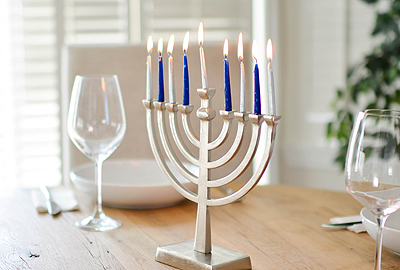
The lighting the menorah traces its origin to a miracle that occurred after the victory of the Maccabees. The Temple in Jerusalem had been defiled by the invading Syrian-Greek army. It was traditional to light a special lamp in the Temple, called a menorah, with olive oil, but all of the vials of oil were made impure, with the exception of one. According to Hannakah history, the one vial of oil burned for eight days until pure oil could be obtained for the holy Temple. In gratitude, the Jews began lighting small menorahs in their homes to commemorate this miracle.
The Hannakah celebration began in the years following the victory, and was observed by lighting a menorah with eight branches (to symbolize the miracle of the oil lasting for eight days) and a ninth holder for a shamash, or "servant" candle that is meant to light the others. The Hannakah celebration is focused on the home, although nowadays there are many large menorahs lit in public areas. The reason for these public Hannakah celebrations is to publicize the miracle.
While the candles are burning, the family traditionally sings Hannakah songs such as Mao Tzur, Haneiros Hololu or "I Have a Little Dreidel". Traditional foods, such as latkes (potato pancakes) and jelly donuts are eaten. The reason foods fried in oil are an important part of the Hannakah celebration is to commemorate the miracle that was associated with oil. Dairy foods, such as blintzes, are eaten to commemorate the role of Judith in Hannakah history; she was the Jewish heroine who gave the Syrian-Greek general, Holofernes, salty cheese that made him thirsty enough to drink too much wine. Once he fell asleep drunk, she killed him with his sword.
The Dreidel
The dreidel is a toy, like a top, that is played while the menorah is burning. It has its origin in Hannakah history; Antiochus refused to allow children to learn their scripture and laws, so the children would play with a dreidel to disguise the fact that they were reciting verses. The dreidel has Hebrew letters on each side, each one with the initial letter of the phrase "A great miracle happened there" (or, for Israeli dreidels, "here")
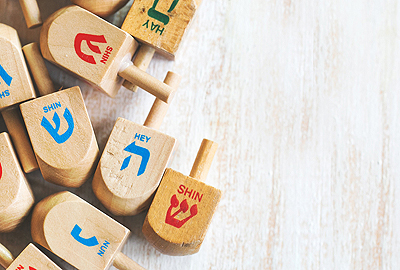
On the dreidel, each of the letters were also representative of how the driedel should be used; the game was played with gelts or chocolate candies in the shape of foiled coins. Every player had an equal number of coins to begin with; the dreidel was then spun. Whatever landed face up would instruct the players on what to do. The word Nun represented the Yiddish word Nisht which meant that the players did nothing. If the letter Gimel landed upright it represented the Yiddish word for gants that means that the player won the entire pot of coins. If the letter Hay landed upright, Yiddish for halb, the player got half of the coin pot. If the letter Shin landed upright, representing the Yiddish word shtel, the player had to put coins into the pot. The game concluded with one player had all of the coins.
The basic Hannakah celebration is the same all over the world, with a few slight variations. In Yemen, children traditionally collect menorah wicks by going door to door (they also ask for candy). In Aden, children wear blue clothing on Hannakah to symbolize the heavens. In Germany, all the leftover wicks are burned on a bonfire on the last night of Hannakah. Different Hannakah songs are sung, depending on the country.
Since the word "Hannakah" is originally written in the Hebrew alphabet, there is no standardized spelling in English, but common spellings are "Hanukkah", "Chanukah", "Hanukah" and "Hanuka". The name "Hannakah" is associated with the most important aspect of Hannakah history: the rededication of the Holy Temple (Hannakah means "dedication"). Hannakah is also referred to as "The Festival of Lights".
The Feast
When it came to feasting, those foods consumed on the holiday were mostly cooked in oils; it is thought that this is to represent the oil that was at one time used to keep the lights burning in the Jewish Temple. Foods include things like donuts cooked in oil or sufganiya, potato pancakes, latkes, and the consumption of cheese is common too in order to remember the heroine Judith who is believed to have protected the village she resided in from the attacks of the Syrians by providing General Holofernes with cheese and wine until he became intoxicated. According to the story, Judith then took the General’s sword and decapitated him with it, returning to her village with his head inside a basket. When the Syrians had discovered this action, it is believed they become fearful and fled the village.
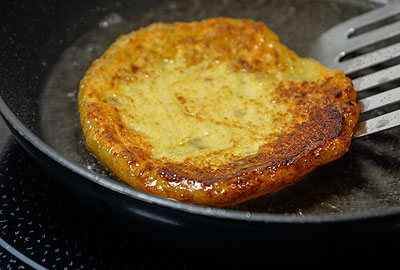
The Hannakah celebration is one of the most joyful in the Jewish calendar. It is embraced worldwide, not just because of its happy theme, but also because of its emphasis on light in the darkest time of the year (at least in the West), when the days are short and the nights are long.
More From Holidays
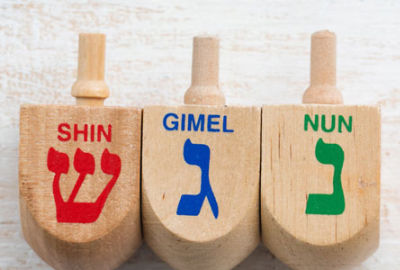 2021-10-09
2021-10-09
History of The Menorah And The Dreidel
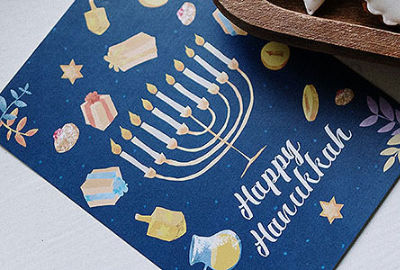 2021-10-09
2021-10-09